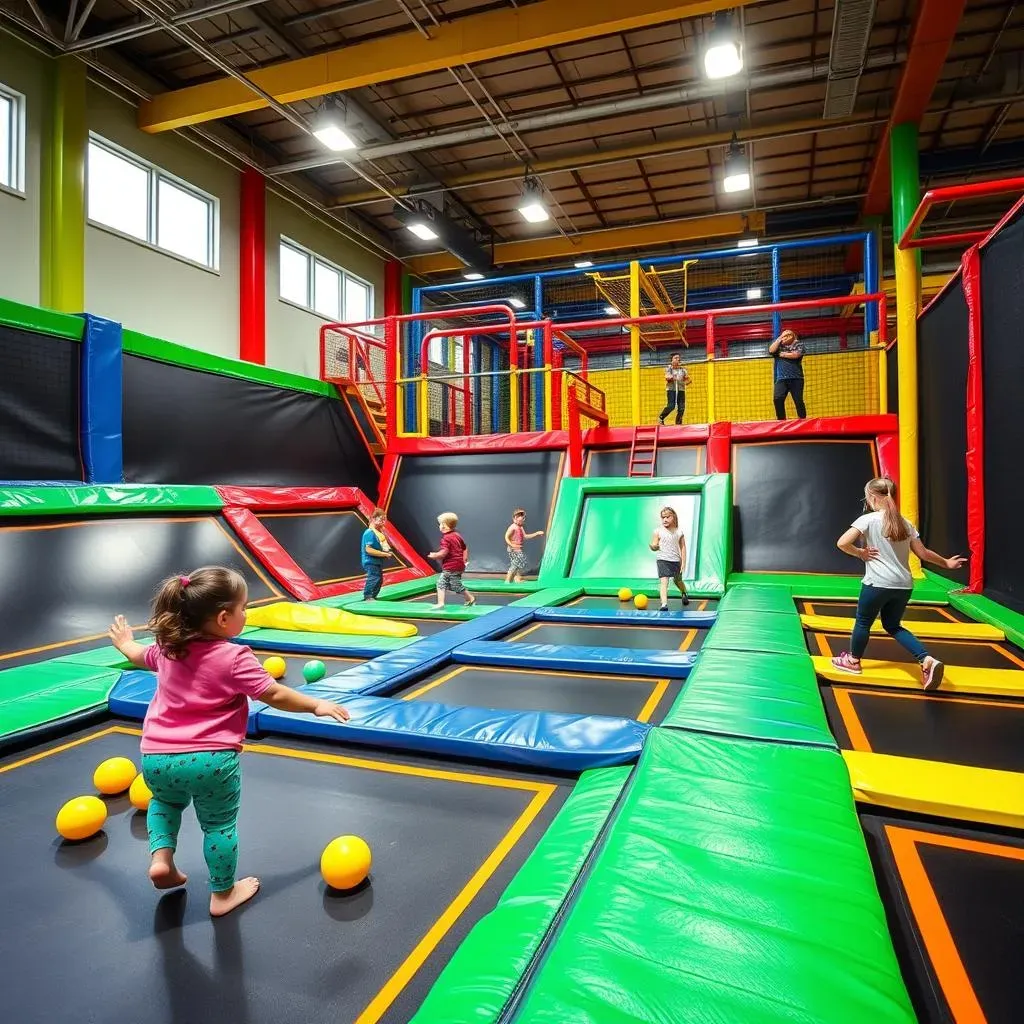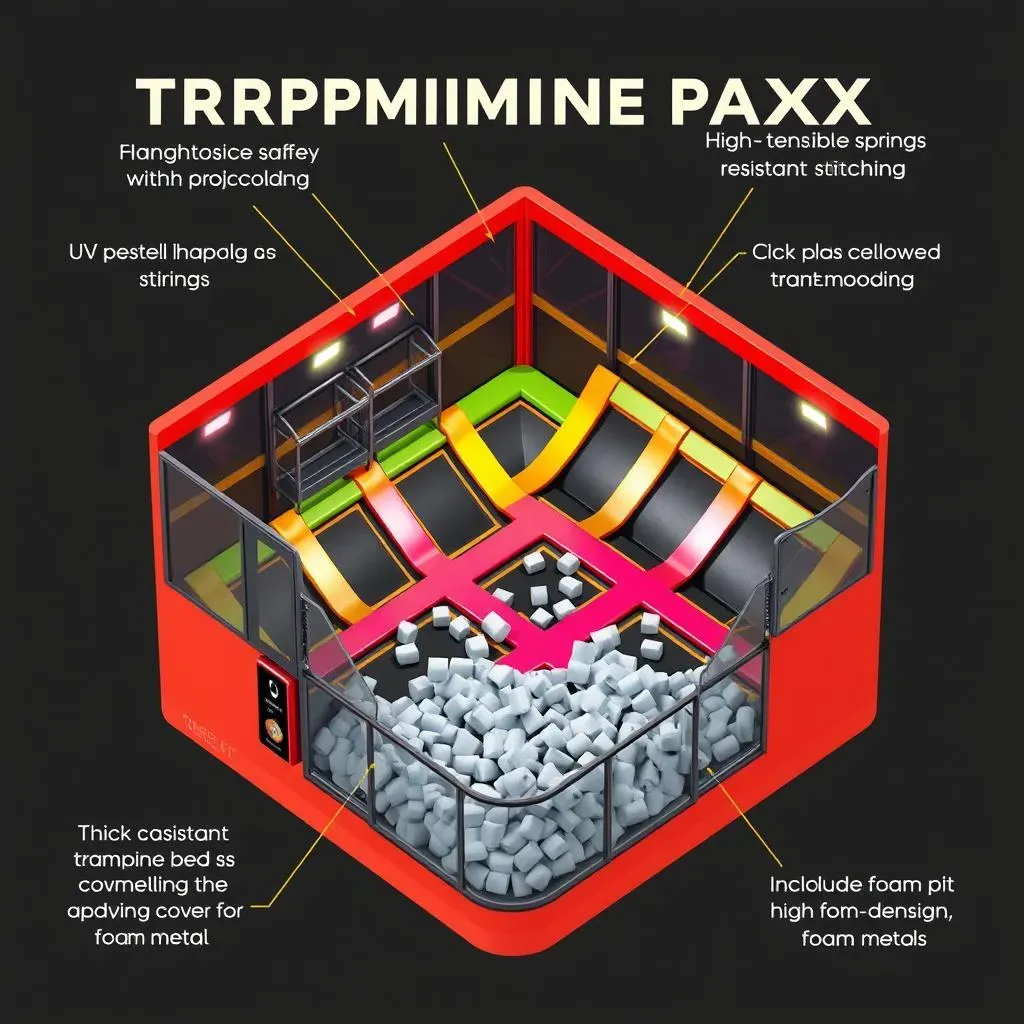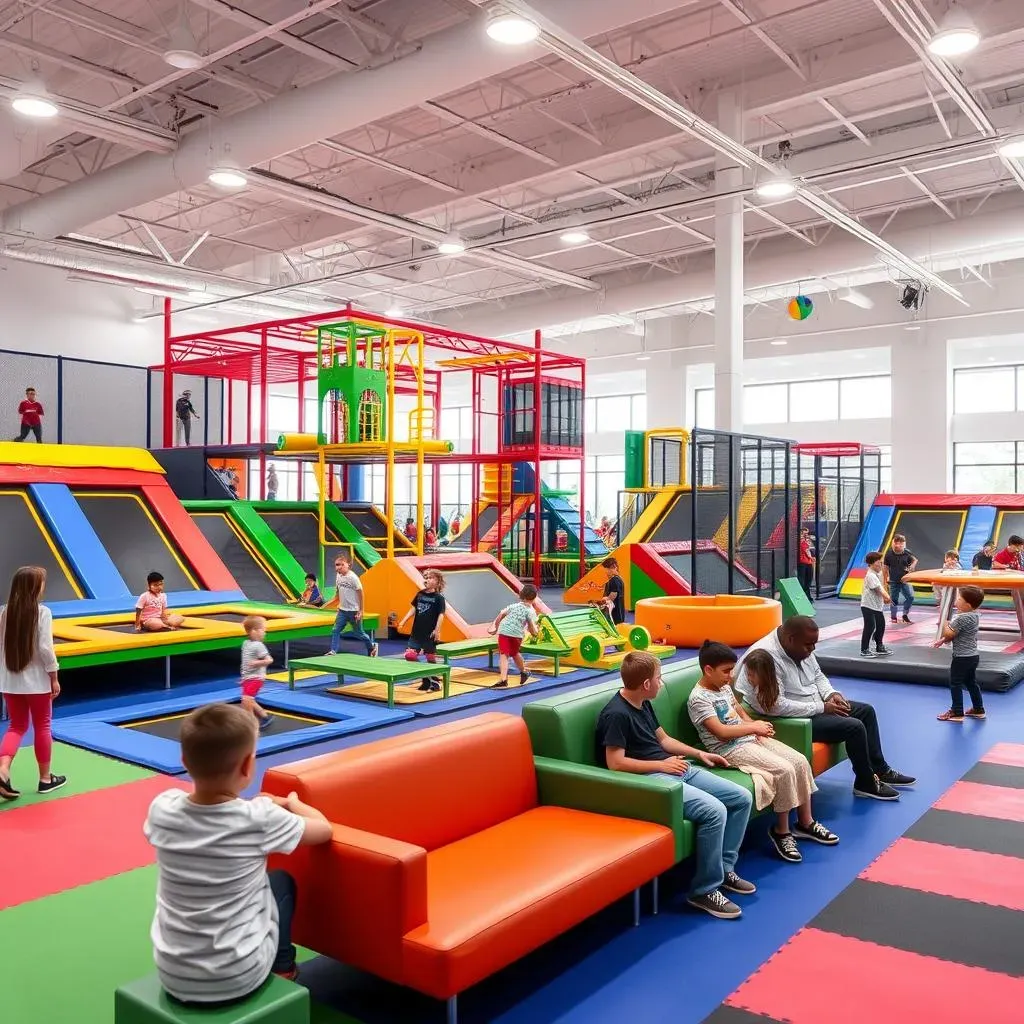Table of Contents
Ready to elevate your indoor play space with the exhilarating bounce of trampolines? Choosing the right indoor playground trampoline equipment is crucial for creating a safe, fun, and engaging environment for kids and adults alike. This isn't just about buying trampolines; it's about crafting an experience that keeps visitors coming back for more. In this guide, we'll walk you through everything you need to know, from understanding key safety standards and features to designing an optimal layout and ensuring long-term maintenance. Whether you're setting up a new family entertainment center, upgrading an existing trampoline park, or simply looking to add a thrilling element to your play area, we've got you covered. Get ready to jump into the details and discover how to select the perfect trampoline equipment to maximize fun and minimize risks, all while creating a memorable experience for your guests. Let's bounce!
What to Consider When Selecting Indoor Playground Trampoline Equipment

What to Consider When Selecting Indoor Playground Trampoline Equipment
Understanding Your Audience and Their Needs
Before you even start browsing catalogs, take a step back. Who are you trying to attract? Tiny tots? Teenage thrill-seekers? Families looking for a fun day out? Knowing your target demographic is key to selecting the right indoor playground trampoline equipment. A toddler area will need soft, low-impact trampolines and foam pits, while a teen area might benefit from more challenging features like angled trampolines or ninja warrior courses. Think about age ranges, skill levels, and the overall experience you want to create. Are you aiming for pure fun, fitness, or a combination of both? Really nailing down these specifics will make the rest of the selection process much smoother.
Also, consider the physical abilities and potential limitations of your target audience. Are you planning to cater to individuals with special needs? If so, you'll need to factor in accessibility and ensure that some of your equipment is designed to be inclusive. Ramps, wider platforms, and specialized harnesses can make a world of difference. Remember, a truly successful indoor playground trampoline equipment setup is one that can be enjoyed by as many people as possible, regardless of their physical capabilities. It's all about creating an inclusive and welcoming environment for everyone.
Target Audience | Equipment Considerations | Example Features |
|---|---|---|
Toddlers (2-5 years) | Soft padding, low heights, enclosed areas | Mini trampolines, foam pits, small slides |
Children (6-12 years) | Moderate heights, varied activities, climbing elements | Standard trampolines, dodgeball courts, climbing walls |
Teenagers & Adults (13+ years) | High heights, challenging features, fitness elements | Performance trampolines, ninja courses, basketball hoops |
Safety First: Prioritizing Quality and Certification
Alright, let's talk safety. This isn't just a box to tick; it's the foundation of your entire operation. When it comes to indoor playground trampoline equipment, you absolutely cannot compromise on quality. Look for reputable manufacturers who adhere to strict safety standards and certifications. ASTM standards are a must. These certifications ensure that the equipment has been rigorously tested and meets specific safety requirements. Don't be afraid to ask manufacturers for detailed information about their safety testing procedures and documentation. A little due diligence now can save you a lot of headaches (and potential liabilities) down the road.
Beyond certifications, pay close attention to the materials used in the construction of the equipment. Are the trampoline mats made of durable, UV-resistant material? Are the springs high-quality and designed to withstand repeated use? Is the padding thick and impact-absorbent? Examine the welds and connections to ensure they are strong and secure. And don't forget about regular inspections and maintenance. Even the best equipment will eventually wear down over time, so it's crucial to have a system in place for identifying and addressing potential safety hazards. Think of it as an investment in the well-being of your customers and the long-term success of your business. Your indoor playground trampoline equipment needs to be safe.
Key Features and Safety Standards for Trampoline Park Equipment

Key Features and Safety Standards for Trampoline Park Equipment
Trampoline Construction and Materials
When diving into key features and safety standards for trampoline park equipment, let's start with the basics: the trampoline itself. The frame needs to be built like a tank, using heavy-gauge steel that can handle constant use and abuse. Look for frames that are powder-coated to prevent rust and corrosion, especially if your facility is in a humid environment. The trampoline beds themselves should be made from high-quality, UV-resistant polypropylene or similar material, capable of withstanding thousands of jumps without tearing or stretching. Seams are crucial, so opt for reinforced stitching that won't unravel under pressure. Remember, a flimsy trampoline is a recipe for disaster. You need something that's built to last and, more importantly, keep jumpers safe. Think of it like the foundation of a house – if it's not solid, everything else is at risk.
Springs are another critical component often overlooked. They should be made of high-tensile steel and designed for consistent performance. Look for springs that are tapered and have a rust-resistant coating. The number of springs, their length, and their placement all contribute to the trampoline's bounce and overall safety. Too few springs, and the bounce will be weak and uneven. Too many, and the trampoline might be too stiff, increasing the risk of injury. It's a delicate balance. And don't forget about spring padding! This is essential for preventing jumpers from accidentally landing on the springs and getting hurt. The padding should be thick, durable, and securely attached to the frame. It's like a safety net for your feet.
Padding and Impact Absorption
Moving beyond the trampoline itself, let's talk about padding – your first line of defense against bumps and bruises. Padding should cover all exposed metal surfaces, including the frame, springs, and any support structures. The thicker the padding, the better the impact absorption. Look for closed-cell foam padding that won't absorb moisture and is easy to clean. Open-cell foam can become a breeding ground for bacteria and is much harder to maintain. The padding should also be securely attached to the frame to prevent it from shifting or coming loose during use. This is where quality fasteners and durable straps come into play. Think of it like wrapping your trampoline in a giant, protective bubble wrap. The more layers, the better.
But padding isn't just about covering surfaces; it's also about creating safe landing zones. Foam pits are a popular addition to trampoline parks, providing a soft and forgiving place to land after a jump. The foam cubes should be made of high-density foam and regularly cleaned and sanitized. Airbags are another option, offering a similar level of impact absorption but with a different feel. They can be inflated or deflated to adjust the level of cushioning. Whichever option you choose, make sure it's properly maintained and inspected regularly. A worn-out foam pit or a deflated airbag is just as dangerous as no padding at all. Your indoor playground trampoline equipment needs these features to be safe.
- Regularly inspect padding for wear and tear.
- Clean and sanitize foam pits and airbags frequently.
- Ensure padding is securely attached to all exposed surfaces.
- Replace damaged padding immediately.
Designing Your Indoor Playground with Trampoline Equipment: Layout and Customization

Designing Your Indoor Playground with Trampoline Equipment: Layout and Customization
Maximizing Space and Flow
so you've got the indoor playground trampoline equipment picked out – awesome! Now comes the fun part: figuring out how to arrange everything. Think of your space as a blank canvas. You want to create a layout that's not only visually appealing but also promotes a smooth flow of traffic. Nobody wants a bottleneck in the middle of their bouncing experience! Start by mapping out the dimensions of your space and identifying any obstacles, like support columns or doorways. Then, consider the different zones you want to create. A dedicated toddler area? A high-flying performance zone? A chill-out area with foam pits? Once you have a general idea of the zones, you can start playing around with the placement of the equipment. Remember to leave ample space between trampolines and other features to prevent collisions. Safety first, always!
Also, think about the flow of movement within each zone. How will people enter and exit the trampoline area? Are there clear pathways to different activities? Consider using visual cues, like colored flooring or signage, to guide visitors and prevent confusion. And don't forget about observation areas for parents or guardians. They'll want to keep an eye on their little ones without getting in the way. Comfortable seating and clear sightlines are key. Ultimately, the goal is to create a space that's both exciting and intuitive, where people can easily navigate and enjoy all the different activities. Your indoor playground trampoline equipment will shine with a good layout.
Customization for Unique Experiences
This is where you can really let your creativity shine! Customization is all about making your indoor playground stand out from the competition. Think beyond just basic trampolines and consider adding unique features that will wow your visitors. Angled trampolines, for example, can add a whole new dimension to the jumping experience. Ninja warrior courses are a huge hit with older kids and adults, providing a challenging and rewarding physical activity. Interactive games, like trampoline dodgeball or basketball, can add a competitive element and encourage teamwork. And don't forget about the theming! A pirate ship trampoline area? A space-themed jumping zone? The possibilities are endless. The key is to create a cohesive and immersive experience that will capture the imagination of your visitors. Your indoor playground trampoline equipment will be more memorable.
But customization isn't just about adding flashy features. It's also about tailoring the experience to your specific target audience. If you're catering to younger children, you might want to focus on soft play elements and interactive games that promote physical and cognitive development. If you're targeting teenagers and adults, you might want to incorporate more challenging activities that test their strength, agility, and coordination. Consider offering different levels of difficulty for each activity to cater to a wide range of skill levels. And don't be afraid to experiment! Try out new features and activities and see what resonates with your visitors. The best way to find out what works is to get feedback from your customers and adapt your offerings accordingly.
Customization Element | Description | Benefits |
|---|---|---|
Theming | Creating a specific theme for the playground (e.g., jungle, space, underwater) | Enhances the immersive experience, attracts specific demographics |
Interactive Games | Incorporating games like trampoline dodgeball or basketball | Adds a competitive element, encourages teamwork, increases engagement |
Ninja Warrior Courses | Adding obstacles and challenges for a more physically demanding activity | Appeals to older kids and adults, promotes fitness and agility |
Accessibility and Inclusivity Considerations
Let's be real, everyone deserves to experience the joy of bouncing! When designing your indoor playground with trampoline equipment, it's super important to think about accessibility and inclusivity. This means making sure that people of all abilities can participate and have a blast. Start by considering the entry points to the trampoline area. Are there ramps or elevators available for people who use wheelchairs or have mobility issues? Are the pathways wide enough to accommodate wheelchairs or other assistive devices? Think about the height of the trampolines. Are there lower trampolines available for people who have difficulty climbing? And consider the padding and safety features. Are they designed to accommodate people with different physical needs? Your indoor playground trampoline equipment can be enjoyed by everyone.
Beyond physical accessibility, it's also important to think about sensory sensitivities. Some people may be sensitive to bright lights, loud noises, or crowded spaces. Consider creating a quiet zone where people can take a break and decompress. Use calming colors and soft lighting throughout the playground. And train your staff to be aware of sensory sensitivities and to provide assistance as needed. Remember, creating an inclusive environment is not just about meeting legal requirements; it's about making everyone feel welcome and valued. And that's something that will benefit your business in the long run.
Maintaining and Maximizing the Lifespan of Your Indoor Playground Trampoline Equipment

Maintaining and Maximizing the Lifespan of Your Indoor Playground Trampoline Equipment
Regular Inspection and Cleaning Protocols
Alright, you've invested in top-notch indoor playground trampoline equipment, designed the perfect layout, and are ready to welcome hordes of bouncing enthusiasts. But the job's not done! Now comes the crucial part: keeping everything in tip-top shape. Think of it like owning a car – you can't just drive it and expect it to run forever without regular maintenance. The same goes for your trampoline park. Regular inspections are key to identifying potential problems before they turn into major headaches (or, worse, safety hazards). Develop a checklist that covers all the critical components: trampoline mats, springs, padding, frames, and any other features you have. Look for signs of wear and tear, such as tears, fraying, loose connections, or damaged padding. Don't just eyeball it – get down on your hands and knees and really examine everything closely. It's time well spent.
And don't forget about cleaning! Trampoline parks can get pretty grimy, especially with lots of kids running around. Develop a cleaning schedule that includes regular sweeping, vacuuming, and sanitizing of all surfaces. Pay special attention to high-touch areas, like handrails and entry points. Use a disinfectant that's safe for both people and the equipment. And don't be afraid to get your customers involved! Encourage them to report any spills or messes to your staff. A clean and well-maintained trampoline park is not only safer but also more appealing to customers. It shows that you care about their experience and are committed to providing a high-quality environment. Your indoor playground trampoline equipment will last longer if you maintain it.
Pro Tip: Keep a detailed log of all inspections and maintenance activities. This will not only help you track the condition of your equipment but also provide valuable documentation in case of any incidents or insurance claims.
- Daily inspection of trampoline mats and springs
- Weekly cleaning of all surfaces
- Monthly inspection of padding and safety features
- Quarterly deep cleaning and sanitization
Repair and Replacement Strategies
No matter how diligent you are with inspections and cleaning, eventually, things will break down. That's just the nature of the beast. So, it's essential to have a plan in place for repairs and replacements. First, identify the parts that are most likely to wear out or break. Trampoline springs, for example, are under constant stress and will eventually need to be replaced. Padding can also wear down over time, especially in high-traffic areas. Keep a supply of spare parts on hand so you can quickly address any issues that arise. This will minimize downtime and prevent any disruptions to your operations. Your indoor playground trampoline equipment is an investment.
When it comes to repairs, don't try to cut corners by using cheap or substandard parts. Always use high-quality replacements that meet the original manufacturer's specifications. And if you're not comfortable doing the repairs yourself, hire a qualified technician. A poorly executed repair can be just as dangerous as a broken part. Also, establish a clear protocol for reporting and tracking repairs. Make sure your staff knows who to contact when they spot a problem and how to document the repair process. This will help you identify recurring issues and make informed decisions about future equipment purchases. Remember, a proactive approach to repairs and replacements will not only extend the lifespan of your equipment but also ensure the safety and enjoyment of your customers.
Component | Common Issues | Recommended Actions |
|---|---|---|
Trampoline Springs | Stretching, breaking, rusting | Replace with high-quality springs, lubricate regularly |
Padding | Tearing, compression, discoloration | Replace damaged padding, clean regularly with appropriate cleaners |
Trampoline Mats | Tears, fraying, stretching | Repair small tears promptly, replace worn mats |
Optimizing Usage and Load Management
Here's a sneaky way to make your equipment last longer: manage how people use it! Overloading trampolines is a surefire way to shorten their lifespan and increase the risk of injury. Implement clear weight limits for each trampoline and enforce them consistently. Train your staff to monitor the number of people on each trampoline and to intervene if they see anyone exceeding the limit. Consider using visual cues, like colored wristbands or signs, to indicate weight limits. This will make it easier for both staff and customers to understand the rules. Your indoor playground trampoline equipment benefits from load management.
Also, think about rotating the use of different trampoline areas. If you have multiple zones, try to alternate which ones are open to the public. This will give the equipment in each zone a chance to rest and recover. And encourage your customers to spread out and use all the different features of the playground. Don't let everyone pile onto the same trampoline! By optimizing usage and load management, you can significantly extend the lifespan of your equipment and minimize the need for costly repairs and replacements.
"The key is not to prioritize what's on your schedule, but to schedule your priorities." - Stephen Covey (Apply this to maintenance!)
Conclusion: Bouncing Towards a Brighter, More Active Future
Investing in high-quality indoor playground trampoline equipment is more than just a business decision; it's an investment in creating joyful, active experiences for your community. By carefully considering safety standards, design, and maintenance, you can create a space that fosters fun, promotes physical activity, and keeps families coming back for more. As the industry evolves, staying informed and prioritizing innovation will ensure your indoor playground remains a vibrant and exciting destination for years to come. So, take the leap, choose wisely, and get ready to watch your space thrive with the boundless energy of happy jumpers!